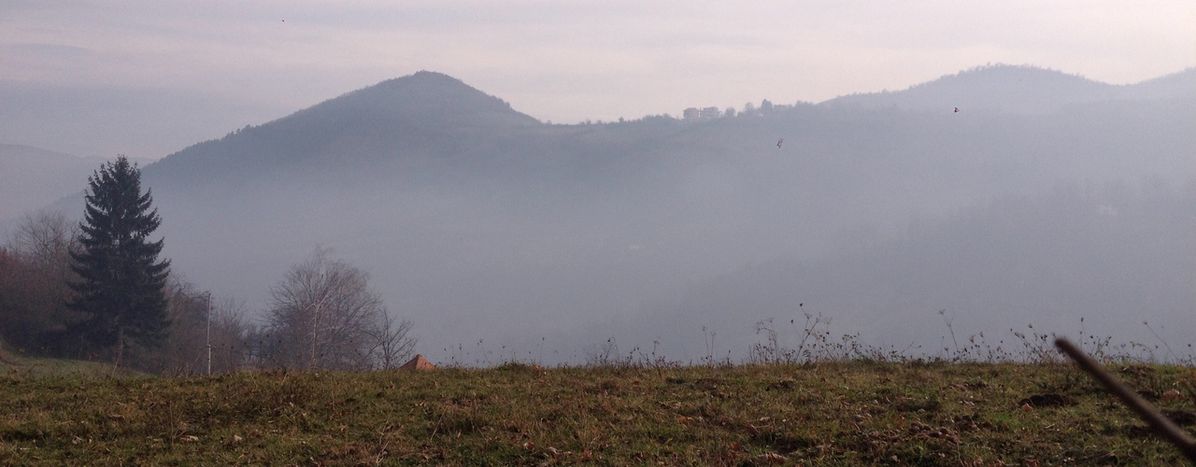
The oldest pyramid in the world is in… Bosnia
Published on
Translation by:
 Jake Nicholls
Jake Nicholls
Who said there was nothing to do in Bosnia? An amateur archaeologist claims to have discovered pyramids in Bosnia, but scientists say that he is lying. Inhabitants of the small town at the foot of the pyramid believe him, but not necessarily for scientific reasons.
Amira Kilalić places pita bread on the table, wraps her headscarf tighter around her bright, dyed red hair, and steps outside. Her shop is a small wooden house that stands on the mountainside. If she looks down, the 83-year-old with a wrinkled face can see Visoko, the town at the foot of the Visočica mountain.
There, women wear high heels to fetch cigarettes, and in the mornings, the men are already sitting in the cafés and betting shops on the main street. If she looks up, Amira can see the castle ruins on the mountaintop.
That’s where the director of the town’s local history museum took a Bosnian entrepreneur, who visited Visoko in 2005. Back then, the ruins were the town's only sightseeing destination. But when the director mentioned the symmetry of the mountain, his visitor stopped short, got out his compass, measured the angle of the mountain's slopes and suddenly became certain that he was standing atop a pyramid.
Not just a mountain in Bosnia
For centuries, the mountain was just a mountain. It wasn't until 2005, when the amateur researcher came to visit, that the mountain became "the highest and oldest pyramid in the world". He called it the 'Pyramid of the Sun' (Piramida Sunca). At the time, the people of Visoko laughed and called him crazy. Today, they are proud of the find, which has brought them fame and money. "It's so nice that the pyramid is right here," Amira says, with a satisfied smile.
The discoverer is called Semir Osmanagić. He makes his living from a metal business in Texas, where he goes by the name Sam Osmanagich. For years, he used to visit the pyramids of the world in his spare time, wearing a wide-brimmed white hat and a cotton shirt. The 57-year-old says that since his discovery, he’s the happiest person in the world. His business has since become a side project; he visits the company four times a year, dealing with any problems over Skype. He can call himself Dr. Osmanagić because, in 2009, he wrote a PhD thesis about the Mayan civilisation at the faculty of political science in Sarajevo.
“I was here in July and took some tunnel water with me. I drank it regularly, and in October, it turned out that I’m free of tumours.”
To Amira, he is simply “Semir”. He began excavations in spring 2006. Every day while doing so, he came by her wooden house – which has neither heating nor a water supply – with his helpers. She gave them apples from her garden and observed how more and more Bosnians and foreigners with hiking boots and cameras were pouring in. When she counted over a thousand people one sunny weekend, her husband decided to open a café. They built a long timber house with a clay floor and large windows, from which Amira now sells coffee and homemade pita, woollen socks and smoked cheese.

The pyramids create jobs, urgently needed in a country with an unemployment rate of almost 30%. Those who can tend to rent out rooms, sell souvenirs or earn money as taxi drivers for the tourists. Since 2005, around 100 new accommodation spaces have sprung up, and pyramid-shaped pizza is easy to find. Osmanagić even formed a Pyramid Foundation, financed by tourism revenue. The foundation employs 38 people: guides, craftspeople and guards. Osmanagić isn’t there very often though, he now gives talks around the world about his discovery. He manages the Visoko team via email.
The amateur archaeologist invites international excavation teams and journalists with him. On the pyramid’s slope, he has exposed stone slabs, and says they are man-made.
Even the head of the European Institute for Archaeology paid the site a visit. He said the find was "a pseudoscientific lie", and that Osmanagić should stop digging. But the amateur researcher didn't back down. Instead, he went on to discover three additional, smaller pyramids and a tunnel that – he believes – leads you to the Pyramid of the Sun. But the alleged passageways are still barricaded by stone.
The accessible part of the tunnel is visited by around 45,000 tourists each year. “We witness miracles here: the highly ionised air in the tunnel, the extraordinary quality of the water, and the vibrations all have positive effects on people,” Osmanagić says over Skype. The entrance fee for foreigners is 10 Euros. There is tunnel water for sale in tiny 100ml glass bottles for the same price.
A place of pilgrimage for occultists
The foundation regularly posts new videos online of people who say that the tunnel has healed them. Herbert from Belgium can see better, and Andreas from Vienna believes that it healed his prostrate cancer. “I was here in July and took some tunnel water with me. I drank it regularly, and in October, it turned out that I’m free of tumours,” he says. Osmanagić hasn't confirmed his witness statement, though.
More and more occultists have come to Amira’s café since then. It doesn’t matter to her, she can’t talk to them anyway because she doesn’t speak any foreign languages. She used to call the mountain behind her house Visočica; now it’s just known as the Pyramid of the Sun. She used to sell coffee for one Bosnian mark; now it’s 1.50.
In the meantime, two new luxury hotels have been built directly next to her wooden house. One of them belongs to a German, she says. More and more foreigners are buying plots of land in Visoko. Someone even came knocking at Amira’s door. He wanted to pay 250,000 Euros for her land on the slopes of the pyramid. Amira’s son decided to wait – the price would surely double. “500,000 Euros!” Amira says. “We’d never have to work again.” But, for the time being, she’ll carry on selling coffee.
Translated from Die älteste Pyramide der Welt steht in... Bosnien


